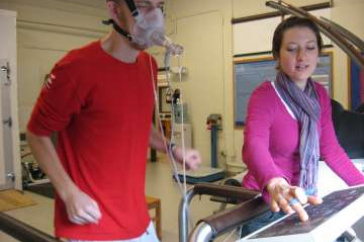UNH Research: Post-Run Ice Baths Not Beneficial for Strength, Soreness

Naomi Crystal '11G conducts research on the effectiveness of post-exercise ice baths in UNH's Robert Kertzer Exercise Physiology Laboratory. Credit: Amy Davies.
DURHAM, N.H. - Dunking in a tub of ice water after exercise - a surprisingly popular post-workout regimen used by athletes to reduce inflammation and speed recovery - is time consuming and bone-achingly painful. New research from the University of New Hampshire finds that it may not be effective, either.
In a study published in the European Journal of Applied Physiology, researchers report that research subjects who engaged in post-exercise cryotheraphy, or ice baths, showed no mitigation of post-exercise strength loss or decreased soreness compared to a control group.
"It doesn't help you feel better and it doesn't help you perform better," says lead researcher Naomi Crystal '11G. "Ice baths are very popular as a treatment, but the research is really mixed as to whether they're beneficial. They're miserable. If it doesn't work, you don't want to waste your time."
The study was Crystal's master's degree thesis; co-authors are UNH associate professor of kinesiology Dain LaRoche, assistant professor of kinesiology Summer Cook, and associate professor of molecular, cellular and biomedical sciences Dave Townson.
For the study, the researchers recruited 20 recreationally active college-age men to run for 40 minutes downhill at a grade of -10 percent. Half the subjects then submitted to a 20-minute ice bath, standing in a tall recycling bin filled with thigh-high ice water cooled to a chilly five degrees Celsius (40 degrees Fahrenheit). "That's really cold," Crystal admits. "I had some guys close to tears."
Crystal was interested in the ice bath's effect on soreness, strength, swelling and inflammation. The researchers conducted three post-exercise measures taken at intervals from one hour to three days: they measured the subjects' perceived soreness while walking down stairs; tested quadriceps strength on a resistance machine; measured thigh circumference; and looked at the concentration of plasma chemokine ligand 2 (CCL2), a marker for inflammation, in blood samples.
The researchers found no difference in strength or perceived soreness between the subjects who took ice baths and the control group. Thigh circumference did not change significantly for any of the subjects after the run.
Difference between the two groups' CCL2 concentrations, while not statistically significant, showed a trend toward lower concentrations in the cryotherapy subjects, although this measure varied greatly between the subjects. "The study suggested that there might have been a mild reduction in inflammation, but it wasn't conclusive," says LaRoche, who was Crystal's advisor.
The lack of difference between the control and the cryotherapy group surprised the researchers. "I expected to see an improvement in soreness, an improvement in strength with the ice bath," says Crystal. She notes that research on ice baths has produced a range of results, in part because there's no standard protocol for the treatment.
LaRoche commends Crystal's study design for using biochemical, physical, and subjective measures, an approach that crossed departmental lines to involve co-authors from her department as well as Townson, from the College of Life Sciences and Agriculture. "It had a variety of ways of looking at whether ice baths were effective or not," he says.
While the researchers state that their study does not support the use of cryotherapy for recovery from exercise, Crystal's personal view is more moderated. "I'm not convinced that it doesn't help at all," she says. "Use them sparingly. Use them in tournament situations, use them with an athlete who has done something extraordinary. But for day-to-day athletes, I wouldn't recommend them. They're painful, and they're time consuming."
The article, "Effect of cryotherapy on muscle recovery and inflammation following a bout of damaging exercise," is available online in the European Journal of Applied Physiology.
The University of New Hampshire, founded in 1866, is a world-class public research university with the feel of a New England liberal arts college. A land, sea, and space-grant university, UNH is the state's flagship public institution, enrolling 12,200 undergraduate and 2,300 graduate students.
Photographs available to download:
/unhtoday/news/releases/2013/08/images/jesse-vo2max-8103_360.jpg
Caption: Naomi Crystal '11G conducts research on the effectiveness of post-exercise ice baths in UNH's Robert Kertzer Exercise Physiology Laboratory.
Credit: Amy Davies
/unhtoday/news/releases/2013/08/images/icebath-1409.jpg
Caption: A chilly subject in a study on the effectiveness of post-exercise ice baths.
Credit: Amy Davies
-30-
Naomi Crystal is available at NaomiJCrystal@gmail.com.
Latest News
-
April 15, 2025
-
Research Finds Rural Americans Carry Heavy Burden Accessing Social Security Benefits and InformationMarch 27, 2025
-
March 25, 2025
-
March 17, 2025
-
March 12, 2025














































